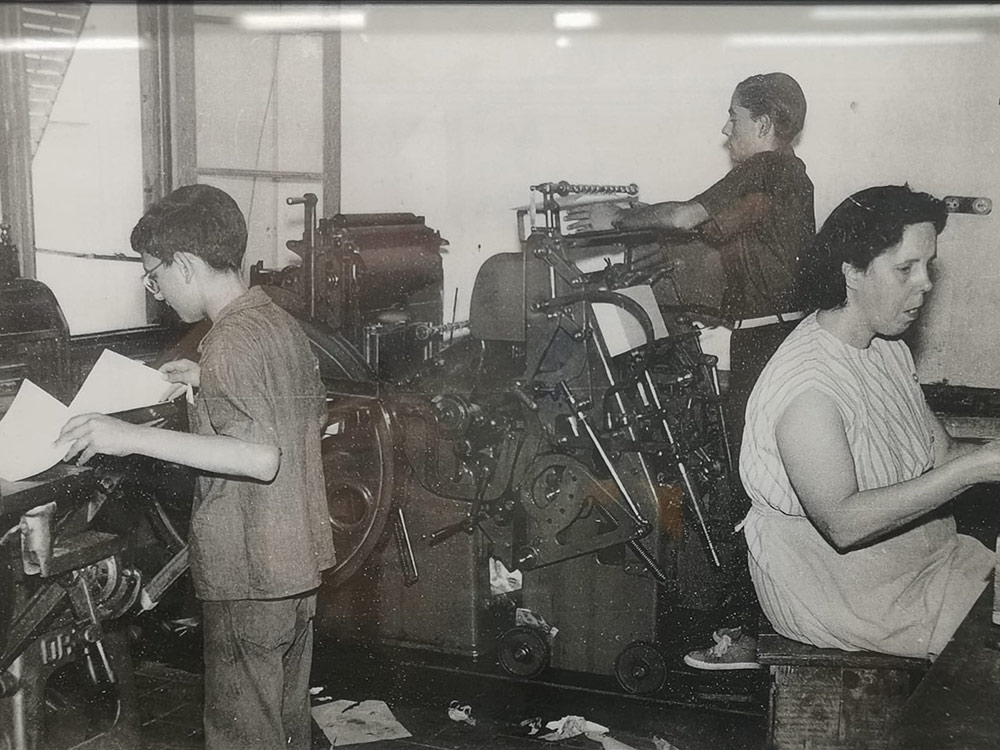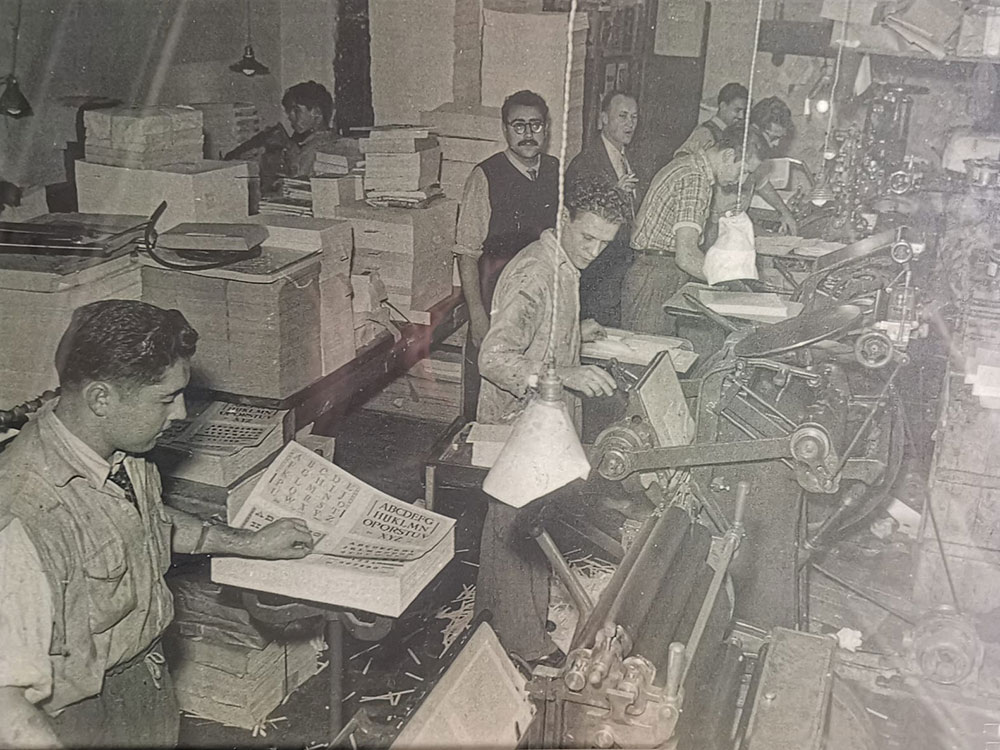Experiences from a career dedicated to printing: “Manual art is disappearing from printing”
Joan Fuster has been around printing machines for almost 50 years. He is currently employed at Gráficas Sort in Sant Llorenç d’Hortons, where he pampers all the paper that reaches him to achieve the best possible result: he is not a die-hard fan of standardisation and believes that nothing is impossible if we set our mind to it. From a very early age he helped his father in a family printing business, where he began to learn about traditional printing machines. Technology has progressed in leaps and bounds, although Joan is not inclined to forego manual art and continues to use more modest printers, which still allow him to implement any project brought to him with this material. We chatted to him about how he personally has experienced this change in printing as well as some of his stories as a professional.
You got into printing when you were still a kid, through the family tradition?
Yes, I have been involved in this world since I was a child. My father worked at a large printer’s, he left and started to work in delivery, transporting the ingredients that “churro” makers needed for their products. He started to talk to the owners when he delivered their products and discovered that they needed bags or paper personalised with the name of their establishment. He bought a small printing machine and set up a small workshop. That is how he started to combine his delivery work with small commissions placed with his own printing facility. This was at the beginning, in carrer Folgueroles in Barcelona.
We then moved to Gelida. I was a very bad student, and since I did not want to have to start again with new classmates in this new place, I stopped going to school (you could only do that in those days) and I started to work with my father in the printing press at the age of 11 or 12. We had flat and automatic machines, I remember that I used to leave a stack of papers ready to be printed there and would go off to play basketball. When I returned I always got into trouble, but the jobs always got done.
What did you specialise in?
Nothing, we printed everything. From calling cards to catalogue, whatever was needed. It is easy to change objects when you know how to print properly.

Machinery has changed a lot since then.
You can say that again, now there are modern machines that were unthinkable when we started out. Despite that, the way things work is basically the same.
Can you do more things with modern printers than with the older ones?
They are completely different worlds. The more modern machines produce a lot more than what I used to, and still do, print. That said, I can solve problems that another printer with more modern machinery cannot. And not just because production is highly standardised: a lot of printers simply do not want to do small print jobs, the trend is to go for the big jobs. Perhaps digital printing is an exception, because it is not so expensive since no plates are required.
Things are no longer done manually. For example, in the past typesetting was very time-consuming. Nowadays, this way of printing things is being copied, albeit with “more practical” techniques. A good typesetter would make sure that there were no signs of pressure on every last letter, nowadays the more the pressure the better. They are different concepts. Furthermore, in the past you used to have to spend a lot of time preparing the machine or the moulds: you had to set all the letters and it could take hours. But nowadays, if you take an hour and half you have the impression that you are being unproductive time-wise.
Processes are much faster nowadays, aren’t they?
Exactly. For example, in the past we used the Linotype machine. They invented a printer that was like a typewriter. You added lead, which melted on the inside, and whenever you struck a letter it would be marked, forming a series of lines with the text that was subsequently printed. When this system emerged it was a revolution. The person composing the moulds formed the phrases or sentences with each one of the lines, and there was no room for mistakes! Because the output could end up being gibberish, and there was no way of fixing it.
Then the rotary machines came out, and they had to create the cylinder mould. When you had what you wanted to print in relief, you applied pressure to a wet cardboard to make sure that it was properly marked and then you melted metal on top of this negative again to make the final mould, which was cylinder-shaped. You could then place it in the rotary machine, where it was wetted with ink and printed continuously on the paper.
All of this, including the moulds, was done by hand. Now you key in the plate text, the machine takes care of the entire process and produces the mould ready for printing.

However, your old machine allows you to tweak more values and items to adapt to the material than the current standard and programmed machines can, doesn’t it?
I can do anything with my machine. Although it is also true that modern machines print in any colour you want and can churn out up to 15,000 sheets an hour. The worst thing is that everything is prepared to work perfectly, without touching hardly anything, only the ink, the plates, the water, and using a very standard paper. They use specific pressures, always with a tolerance margin, although they cannot apply more than a certain amount of kilograms of pressure, which limits the substrates that can be used.
On the other hand, my machine, which cannot print as quickly as the other ones because it would explode, is much better because I can adapt it manually on the fly to ensure that the result will be perfect or deal with any issues that crop up. For example, I can adjust pressures a great deal more. Sometimes, high-quality papers need that extra bit of pressure to deliver a good result when the ink is applied. This problem does not occur with offset materials, because the quality is inferior and less pressure is applied to ensure that the ink is applied evenly. However, this does not mean that quality papers are more complicated: you just need to know how to work with them and apply the right pressure that they need.
Would you rather work with coated or offset paper?
I would rate both of them equally: they need more or less dedication, but you need to do your bit as well. That said, coated is easier to work with than offset. In offset you need more ink, the weave needs to be thicker to make sure that it is not covered, etc., provided that the coated paper is well made, because some of them are poorly manufactured.
Have inks changed a lot as well?
Definitely, now they are practically perfect. In the past, sometimes you had to add a liquid drying agent to an ink because it smudged a lot. And sometimes it took as much as 24 or 48 hours to dry. Nowadays, you can stack printed papers up really high – which is a lot of kilos – and they are dry in a jiffy.
Choosing the right ink for the paper you are going to use is also crucial. The combination must be right for it to work well. Basically, it is a matter of fiddling about with two materials. Then you have the question of the machine, and really wanting to work with paper properly. We live and learn.
You have been in the sector for years, and machinery has changed a lot. Do you think that many changes still lie ahead in printing?
I have often thought that in printing there will come a time when you will just stack up a load of paper and all the sheets will be printed at the same time by laser or a similar system. It may seem a bit far-fetched, but seeing how things have evolved in such a short time I think that the rapid evolution of technology will bring many new developments.
